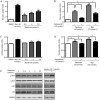Danthron activates AMP-activated protein kinase and regulates lipid and glucose metabolism in vitro
- PMID: 23770982
- PMCID: PMC4003022
- DOI: 10.1038/aps.2013.39
Danthron activates AMP-activated protein kinase and regulates lipid and glucose metabolism in vitro
Abstract
Aim: To discover the active compound on AMP-activated protein kinase (AMPK) activation and investigate the effects of the active compound 1,8-dihydroxyanthraquinone (danthron) from the traditional Chinese medicine rhubarb on AMPK-mediated lipid and glucose metabolism in vitro.
Methods: HepG2 and C2C12 cells were used. Cell viability was determined using MTT assay. Real-time PCR was performed to measure the gene expression. Western blotting assay was applied to investigate the protein phosphorylation level. Enzymatic assay kits were used to detect the total cholesterol (TC), triglyceride (TG) and glucose contents.
Results: Danthron (0.1, 1, and 10 μmol/L) dose-dependently promoted the phosphorylation of AMPK and acetyl-CoA carboxylase (ACC) in both HepG2 and C2C12 cells. Meanwhile, danthron treatment significantly reduced the lipid synthesis related sterol regulatory element-binding protein 1c (SREBP1c) and fatty acid synthetase (FAS) gene expressions, and the TC and TG levels. In addition, danthron treatment efficiently increased glucose consumption. The actions of danthron on lipid and glucose metabolism were abolished or reversed by co-treatment with the AMPK inhibitor compound C.
Conclusion: Danthron effectively reduces intracellular lipid contents and enhanced glucose consumption in vitro via activation of AMPK signaling pathway.
Figures





Similar articles
-
Polydatin Improves Glucose and Lipid Metabolisms in Insulin-Resistant HepG2 Cells through the AMPK Pathway.Biol Pharm Bull. 2018;41(6):891-898. doi: 10.1248/bpb.b17-01027. Biol Pharm Bull. 2018. PMID: 29863077
-
Coniferaldehyde ameliorates the lipid and glucose metabolism in palmitic acid-induced HepG2 cells via the LKB1/AMPK signaling pathway.J Food Sci. 2020 Nov;85(11):4050-4060. doi: 10.1111/1750-3841.15482. Epub 2020 Oct 10. J Food Sci. 2020. PMID: 33037652
-
Honokiol activates the LKB1-AMPK signaling pathway and attenuates the lipid accumulation in hepatocytes.Toxicol Appl Pharmacol. 2015 Apr 15;284(2):113-24. doi: 10.1016/j.taap.2015.02.020. Epub 2015 Feb 28. Toxicol Appl Pharmacol. 2015. PMID: 25737164
-
Irisin ameliorates hepatic glucose/lipid metabolism and enhances cell survival in insulin-resistant human HepG2 cells through adenosine monophosphate-activated protein kinase signaling.Int J Biochem Cell Biol. 2016 Sep;78:237-247. doi: 10.1016/j.biocel.2016.07.022. Epub 2016 Jul 21. Int J Biochem Cell Biol. 2016. PMID: 27452313
-
Refining sugar's involvement in cholesterol synthesis.Biochim Biophys Acta Mol Cell Biol Lipids. 2023 Mar;1868(3):159266. doi: 10.1016/j.bbalip.2022.159266. Epub 2022 Dec 14. Biochim Biophys Acta Mol Cell Biol Lipids. 2023. PMID: 36528253 Review.
Cited by
-
A Knowledge-Graph-Based Multimodal Deep Learning Framework for Identifying Drug-Drug Interactions.Molecules. 2023 Feb 3;28(3):1490. doi: 10.3390/molecules28031490. Molecules. 2023. PMID: 36771157 Free PMC article.
-
Identification of danthron as an isoform-specific inhibitor of HEME OXYGENASE-1/cytochrome P450 reductase interaction with anti-tumor activity.J Biomed Sci. 2018 Jan 23;25(1):6. doi: 10.1186/s12929-018-0411-y. J Biomed Sci. 2018. PMID: 29361943 Free PMC article.
-
Probucol suppresses human glioma cell proliferation in vitro via ROS production and LKB1-AMPK activation.Acta Pharmacol Sin. 2014 Dec;35(12):1556-65. doi: 10.1038/aps.2014.88. Epub 2014 Nov 17. Acta Pharmacol Sin. 2014. Retraction in: Acta Pharmacol Sin. 2018 Feb;39(2):328. doi: 10.1038/aps.2018.2. PMID: 25399650 Free PMC article. Retracted.
-
Lipid metabolic reprogramming by traditional Chinese medicine and its role in effective cancer therapy.J Cancer. 2023 Jul 9;14(11):2066-2074. doi: 10.7150/jca.86683. eCollection 2023. J Cancer. 2023. PMID: 37497413 Free PMC article. Review.
-
Chinese herbal medicine on dyslipidemia: progress and perspective.Evid Based Complement Alternat Med. 2014;2014:163036. doi: 10.1155/2014/163036. Epub 2014 Feb 13. Evid Based Complement Alternat Med. 2014. PMID: 24688589 Free PMC article. Review.
References
-
- DeFronzo RA, Ferrannini E. Insulin resistance. A multifaceted syndrome responsible for NIDDM, obesity, hypertension, dyslipidemia, and atherosclerotic cardiovascular disease. Diabetes Care. 1991;14:173–94. - PubMed
-
- Grundy SM. Obesity, metabolic syndrome, and cardiovascular disease. J Clin Endocrinol Metab. 2004;89:2595–600. - PubMed
-
- Kahn BB, Alquier T, Carling D, Hardie DG. AMP-activated protein kinase: ancient energy gauge provides clues to modern understanding of metabolism. Cell Metab. 2005;1:15–25. - PubMed
-
- Zhang BB, Zhou G, Li C. AMPK: an emerging drug target for diabetes and the metabolic syndrome. Cell Metab. 2009;9:407–16. - PubMed
-
- Yu LF, Qiu BY, Nan FJ, Li J. AMPK activators as novel therapeutics for type 2 diabetes. Curr Top Med Chem. 2010;10:397–410. - PubMed
Publication types
MeSH terms
Substances
LinkOut - more resources
Full Text Sources
Other Literature Sources
Research Materials
Miscellaneous

